Called the Grand Canyon of Pennsylvania, the 47-mile Pine Creek Gorge carves out a recreational paradise for paddling, hiking, biking and world-class fishing
Tyler Grim had the chance to leave and didn’t: Such is the power of Pennsylvania’s Grand Canyon. He grew up in the tiny town of Wellsboro, on the edge of the canyon in Tioga County, in the rugged hills of what’s known as the “Pennsylvania Wilds.” That’s the name marketers have given to the north-central portion of the state dominated by huge chunks of public land.
Later Grim attended Mansfield University, just a 20-minute drive away. Then he went to work for his parents, owners of Stony Fork Creek Campground.
And then? Well, he decided to go out on his own and run his own campground. He could have gone anywhere, even Florida, where he spends a few months each winter, “like a schoolteacher in reverse.”
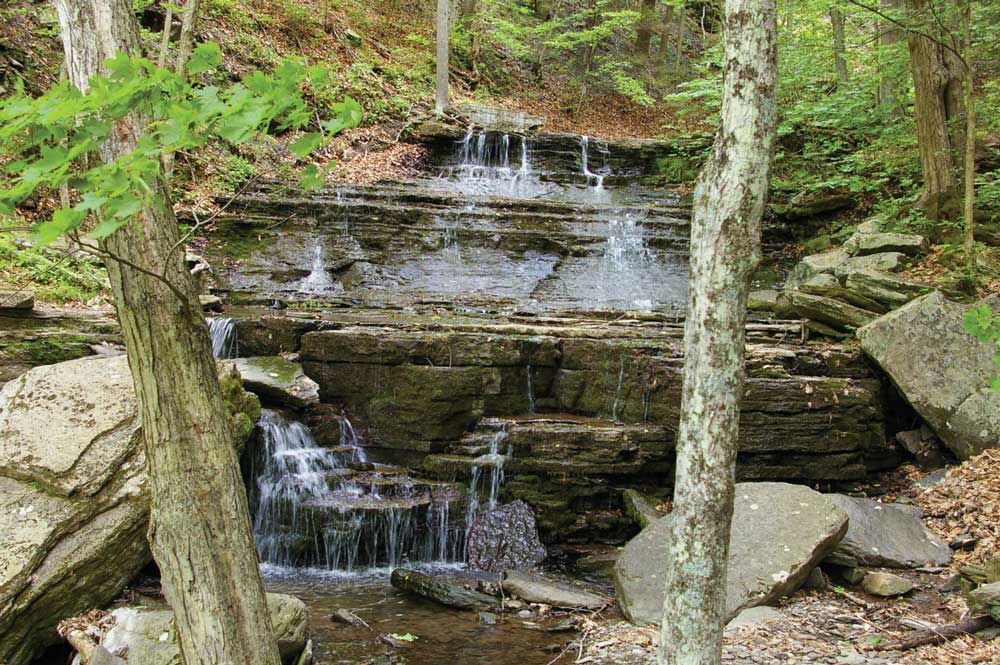
The Turkey Path Trail down to the bottom of the canyon is a steep walk, but the waterfalls along the way make it worth the trek.
Instead, he bought Canyon Country Campground, almost on the lip of the canyon and in the same woods where he grew up and has lived his whole life.
“It’s just such a beautiful area,” Grim said by way of explanation. “There’s just lots to see and do. And, this is funny, but the cell-phone service is not that good, and that’s a plus. So you can really get out and explore and disconnect.
“I like that myself,” he added, “so I decided there was nowhere really better to be.”
Lots of folks who visit Pennsylvania’s Grand Canyon come away thinking the same thing. The canyon, a National Natural Landmark, stretches 47 miles. It’s 2 miles wide and 1,000 feet deep in spots, carved by lovely Pine Creek through the Allegheny Plateau.
The surrounding countryside — nearly 200,000 acres worth of state parks and forests — offers as great a chance to see black bears, white-tailed deer and bald eagles as people.
“One of the things I love about it up here is that I can go out my front door, get in my Jeep and drive 70 miles in a day’s time, and never leave a dirt road,” said Tom Finkbiner, who has operated Slate Run Tackle Shop at the south end of the canyon for 40 years.
What really gets people excited is the canyon’s remote heart, the 16 miles between Ansonia and Blackwell. It’s shallower there, maxing out at about 800 feet, but also narrower, sometimes less than half that wide.
At the bottom sit a handful of permanent camps and a few places to pitch a tent. But otherwise, for miles-long stretches, there’s nothing but trees, water, wildlife and, at night, stars. This area is the darkest on the East Coast, with Cherry Springs State Park, the world’s second International Dark Sky Park, nearby.
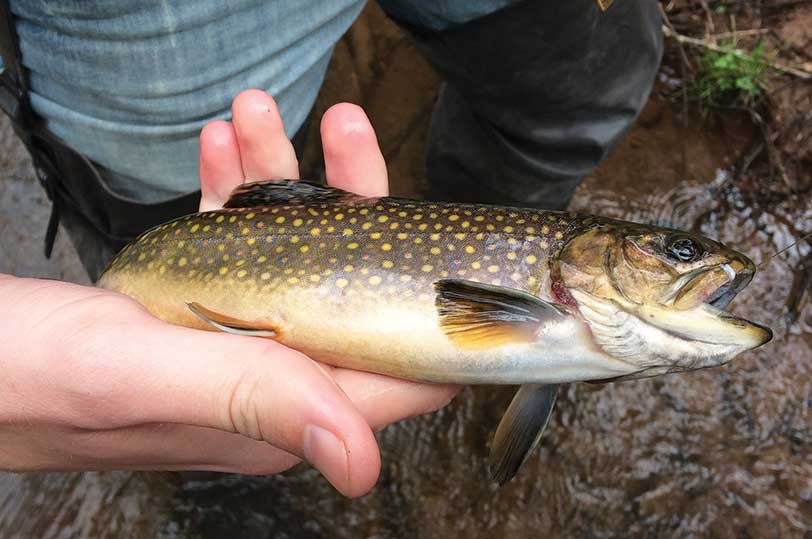
Anglers who cast their lines into Pine Creek hope to catch brown trout like this, as well as smallmouth bass.
“For basically 16 miles, it’s about as primitive as you can get in Pennsylvania,” said Chris Gastrock, district forester of Tioga State Forest, who manages a portion of it. “It’s more rugged than people imagine. There are quite a few bald eagles here. We’ve got black bears, otters, timber rattlesnakes, white-tailed deer, all in a setting that’s unique.
“There’s really nothing else like, at least not in this state.”
People come to experience the canyon in different ways. For many, that’s via the Pine Creek Rail Trail. Running 62 miles and mostly flat, with just a 3 percent grade, it’s a favorite of hikers and bikers. It’s been rated one of the top 10 such trails in the country in terms of scenery.
Some do day trips, and others camp along the way at designated sites maintained by the bureau of forestry. Others use local outfitters to shuttle them and their bikes around.
Either way, it pays to be prepared. From Ansonia downstream for 8 miles, there are a couple of primitive rest-rooms, but the next 8 miles have no amenities at all. And the weather can be surprisingly challenging.
“You wouldn’t think it with the stream right there, but it does get hot,” Gastrock said. “With the canyon walls and no breeze and the trail surface, it can get tough. That’s why we always tell people to take lots of water.”
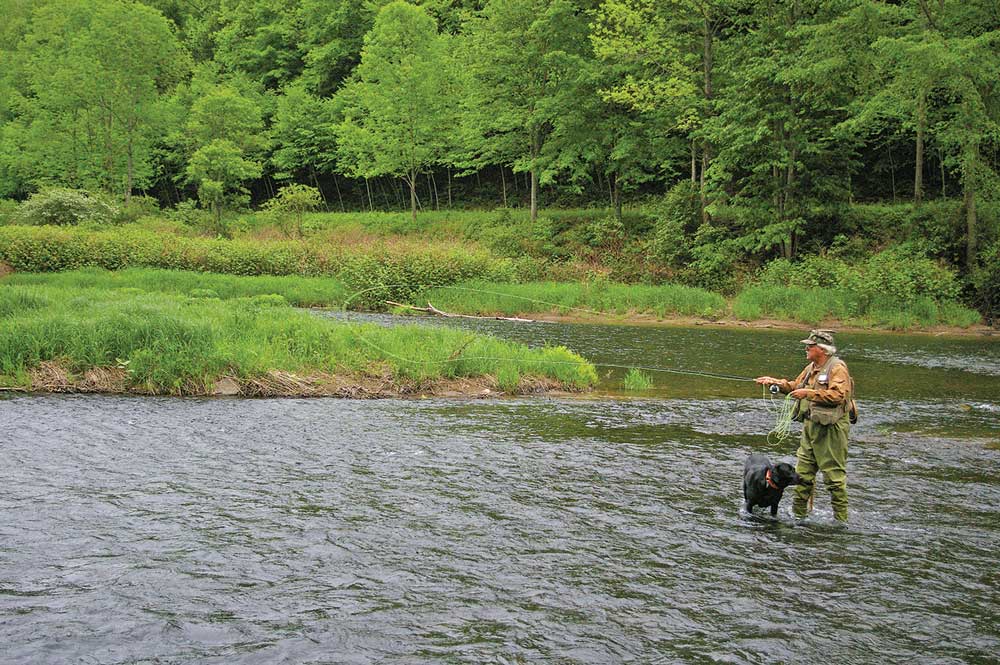
Bob Childs of Big Meadows Fly Shop fishes Pine Creek with his trusty companion, a black
Labrador known as Sir Odie of Ansonia.
The effort is worth it. History buffs like forest ranger Jim Losinger know that. His family has lived in the area for generations, and a couple of hollows off the canyon bear relatives’ names. Losinger can walk the trail and point to evidence of the area’s past.
One example is the remnants of the Darling Run Camp that was operated by the Civilian Conservation Corps from 1935 to 1941. Members of the camp and other young men put to work building the infrastructure of state parks and forests during the Great Depression are memorialized in displays at Leonard Harrison State Park, one of two state parks that sit on the rim of the canyon. It’s on the east rim, and Colton Point State Park is on the west.
Along the trail, visitors can see and feel where those men actually lived. Some carved their initials and the date they were there in the rocks. Elsewhere, bits of their handiwork survive.
“If you know where to look, or ask, there’s a lot more history in the canyon than people expect or understand,” Losinger said. “Some of it’s hidden, and nature’s slowly taking over, but it’s there.”
Others visit the canyon for its unique and often wonderful fishing. Jason Detar, chief of the Pennsylvania Fish and Boat Commission’s fisheries management division, calls Pine Creek “a destination fishery.”
“In terms of the scenic nature of things, it’s hard to beat,” he said. “But that’s not to say the scenery is the only thing, or even the main attraction. There’s some pretty good angling to be had, for trout early and late in the year, and for warm-water species
like smallmouth bass in between.
It’s definitely got potential.”
The commission stocks trout in 55 miles of Pine Creek, with only a few gaps between the Genesee Forks and Slate Run. The fishing is often surprisingly uncrowded, too.
Opening day of trout season, which falls in mid-April, brings crowds, but they last only a few weeks, said Don Kelly, owner of Wellsboro Tackle Shack. “Once the spring trout fishermen thin out, the stream isn’t very crowded. It doesn’t get too much pressure,” he said.
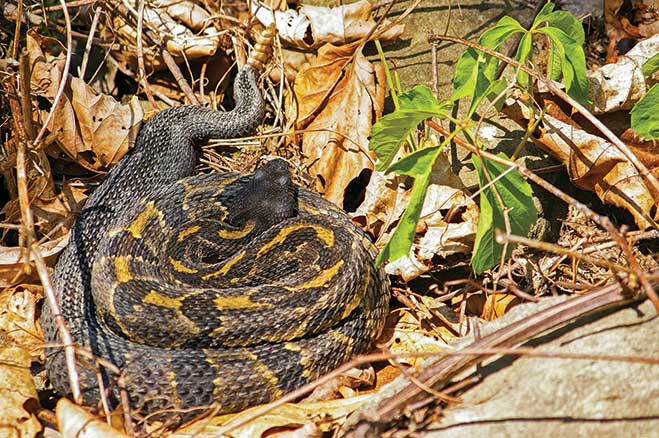
Timber rattlesnakes show themselves occasionally on the Pine Creek Rail Trail. They’re not aggressive, but it’s wise to keep your distance.
Bob Childs, owner of Big Meadows Fly Shop in Ansonia, agreed. He often fishes with his Labrador retriever, Sir Odie of Ansonia, out of his tiny fly shop, which sits in a couple of rooms off a corner of his home. He said it’s not uncommon to catch dozens of fish in
an outing, with the only competition the occasional black bear.
“The fishing on Pine is fantastic, more so than people realize,” Childs said. “I know we don’t have a lot of people who live around here full-time, but every time I’m on the stream and
I have it all to myself, I can’t believe it.
If more people knew about just how good the fishing is, and knew that it wasn’t just a few weeks in the spring type of thing, we’d have more people here, no doubt. Or at least we should.”
Two stream sections in particular rate as must-sees, if for different reasons. One, for scenic purposes, is the Ansonia-to-Blackwell stretch. The northernmost 8 miles gets stocked with adult-size, catchable trout. They provide action in spring and fall, as well as in summers when enough rain falls consistently to keep water temperatures cool.
When the trout aren’t cooperative, there’s always smallmouth bass. Plenty of fish up to 15 inches can be caught, Detar said, and Childs has seen and caught 3- and 4-pounders.
“Anything that matches the creek’s little chubs, its minnows, its smaller fish, they all work for them,” Childs said. “Crayfish patterns are good, too.
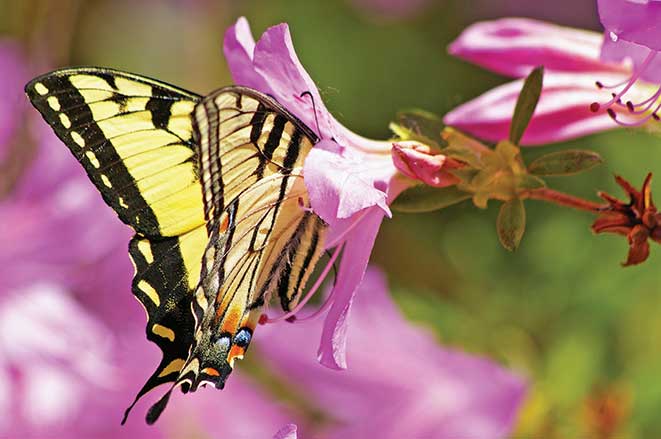
Butterflies and flowers give Pennsylvania’s Leonard Harrison State Park a splash of color, too.
I never saw so many crayfish in a stream until I moved here. Or I fish a hellgrammite pattern up to 6 inches long, and they just attack it.”
The other hot spot is the 2.8 miles of Pine Creek from Slate Run downstream to Bonnell Run. That’s where the Brown Trout Club, a group supported by donations and run out of Finkbiner’s shop, stocks almost $20,000 worth of browns in the creek annually.
These aren’t just any trout. Most run 14 to 15 inches long, with some reaching 20 or even 30 inches. They hit the stream as some of the most pampered fish on the planet. Finkbiner buys them from only two suppliers who grow them in cold-water earthen ponds, ensuring that they enter the water fat, colorful and free of the scars common on trout raised in concrete raceways.
“These are exceptionally high-quality trout grown in a low-density environment,” Finkbiner said. “When you catch these fish, they look like absolutely wild trout you might find in a spring creek or a Western river.” The result is what he calls a “world-class fishing experience,” the opportunity to catch large trout on public water in a gorgeous setting.
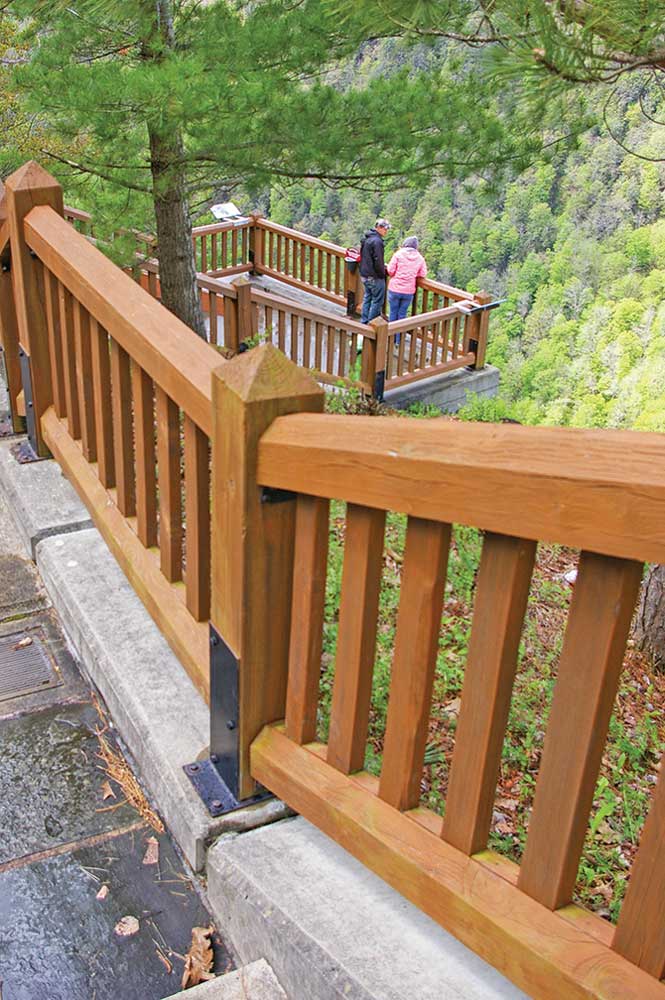
Leonard Harrison State Park has a well-
developed viewing area, a small visitor center and a gift shop.
The season is year-round for all types of tackle, but the fishing is catch and release. Finkbiner said he encourages anglers to leave the trout unmolested between mid-June and September for fear the stress of being caught when water temperatures hit their summer peak might prove fatal.
In warm weather it’s better to fish for the creek’s many smallmouth bass, walleyes and channel cats. In spring, fall and even winter, though, the trout fishing can be fantastic, he said.
“If you’re on the water when there’s a good hatch going on, you can get a half-dozen fish a day from the upper teens into the 20 inches,” Finkbiner said. “And I know guys who have done better than that.”
A number of tributaries to Pine Creek hold native brook trout. “Really, people can’t go wrong anywhere on Pine Creek,” Detar said. “There’s a lifetime of water to fish.”
Other outdoor enthusiasts visit the area for the boating. In most years Pine Creek can be floated from March until about Memorial Day. Then, unless there’s been sufficient rain, water levels get too low.
Pine Creek is mostly calm water in the Class I category, with one Class III section known as Owassee Rapids, but outfitters can guide almost any paddler through the whitewater in
a kayak or raft.
There’s hiking to be had, too.
A lot of visitors start at Colton Point State Park, which features overlooks, a visitor center with displays and a movie detailing the area’s history, a Civilian Conservation Corps memorial and a gift shop. Hiking from the rim of the canyon to the creek along the Lost Turkey Trail — a steep switchback of a path, to be sure — leads past several waterfalls.
Others hike 4 miles along the rail trail from the Darling Run access, home to one of the most visible bald eagle nests on the creek, then climb to the top of Turkey Path Trail.
Still more trails, most offering breathtaking scenery, follow the rim of the canyon. Many start at Colton Point and in the surrounding state forest. No matter how they explore the canyon, visitors tend to come away impressed.
“We can keep you busy for three or four days, easily,” Grim said. “The hiking, the biking, the fishing, that’s all fun. There are covered wagon rides through the canyon, too, and they sometimes let the kids drive. That makes it a lot of fun. Families love that.
“Usually, people come, they spend a long weekend, and they leave wanting to come back and do more.”
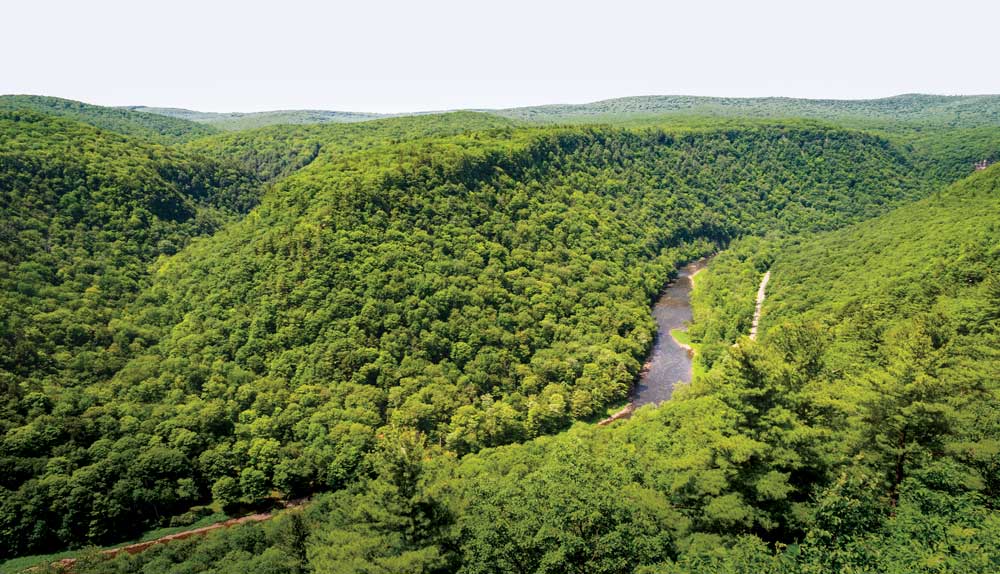
Pennsylvania’s Grand Canyon is a land of rugged beauty with large tracts of state forest and state parks.
If You Go

RAFTING
Guided rafting trips through Pennsylvania’s Grand Canyon are available through Pine Creek Outfitters. The Ansonia store also offers kayak, canoe, raft and bike rentals, fishing and backpacking gear, maps and guidebooks.
570-724-3003 | www.pinecrk.com
FISHING
Fly-fishing tours and information on the Brown Trout Club are available at Slate Run Tackle Shop, an Orvis dealership in Slate Run. The store stocks sporting goods, and the adjacent Wolfe’s General Store offers grocery and deli items and a gift shop.
570-753-8551 | www.slaterun.com
CAMPING
When it comes to RV camping, there are several options, from public parks to privately owned campgrounds. Some state parks, like Leonard Harrison, offer modern facilities and electric hookups, while others, like Colton Point, are more rustic. Full-service campgrounds, such as Tyler Grim’s Canyon Country in Wellsboro, have more amenities.
COVINGTON
Tanglewood Camping
570-549-8299, www.tanglewoodcamping.com
MORRIS
Twin Streams Campground
570-353-7251 | www.twinstreamscampground.com
WATERVILLE
Little Pine State Park
570-753-6000 | www.dcnr.pa.gov/stateparks/findapark/littlepinestatepar
WELLSBORO
Canyon Country Campground
570-724-3818 | www.canyoncountrycampground.com
Colton Point State Park
570-724-3061 | www.dcnr.pa.gov/stateparks/findapark/coltonpointstatepark
Leonard Harrison State Park
570-724-3061 | www.dcnr.pa.gov/stateparks/findapark/leonardharrisonstatepark
Stony Fork Creek Campground
570-724-3096 | www.stonyforkcamp.com

